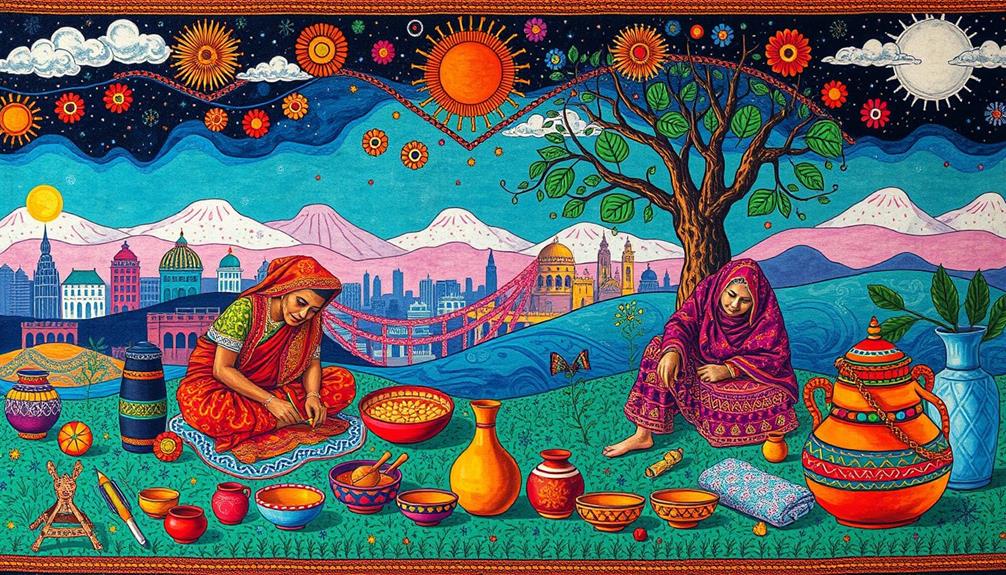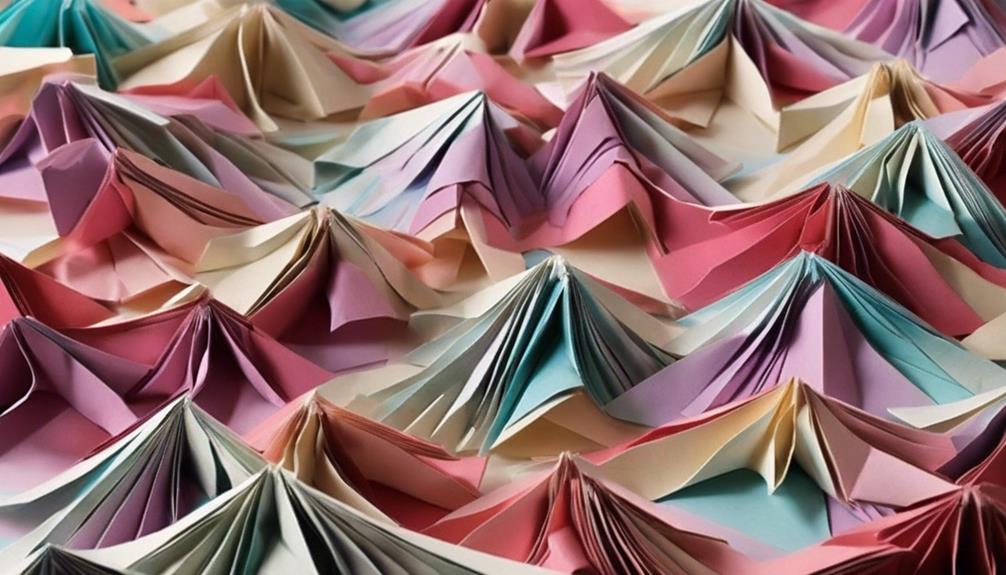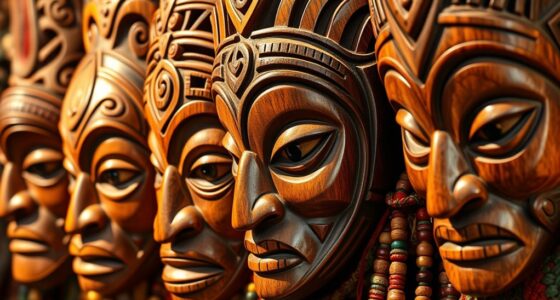Abstract art, with its roots in the early 20th century, revolutionized traditional artistic forms. It emphasizes pure expression, texture, and composition, challenging viewers' perceptions in intriguing ways. By utilizing colors, shapes, and patterns, artists evoke emotions and convey themes. Abstract art encourages curiosity, creativity, and experimentation, aiming to evoke a wide array of emotions and interpretations. Through unique techniques and manipulation of elements, abstract art embodies a transformative power that can reshape one's perception of the world.
Key Takeaways
- Abstract art challenges traditional perception.
- Utilizes shapes, colors, and textures to evoke new perspectives.
- Promotes innovative interpretations and emotional connections.
- Encourages viewers to explore subjective narratives.
- Stimulates curiosity and creativity through enigmatic compositions.
Origins of Abstract Art
Emerging in the early 20th century, abstract art revolutionized traditional artistic expression by focusing on non-representational forms. One of the pioneers in this movement was Wassily Kandinsky, a Russian artist known for his groundbreaking work in abstract art. Kandinsky's shift away from representational art towards pure expression paved the way for a new form of artistic interpretation.
His paintings, such as 'Composition VII' and 'Yellow-Red-Blue,' exemplify the use of shapes, colors, and lines to evoke emotions and convey inner feelings without relying on recognizable subject matter.
Kandinsky's influence on abstract art extended far beyond his own creations, inspiring a generation of artists to explore the depths of self-expression through non-representational forms. By emphasizing the power of color, shape, and line to create movement, depth, and texture in artworks, Kandinsky played a significant role in shaping the evolution and development of abstract art as a genre.
Key Characteristics of Abstract Art

Abstract art captivates viewers through its unique characteristics that emphasize shapes, colors, and lines to evoke emotions and create visual interest. Artists in the genre focus on non-representational forms, using elements like texture and composition to draw viewers into the artwork, creating a sense of movement and depth. Originating in the early 20th century as a departure from representational art, abstract art emphasizes pure expression, allowing for self-expression and communication of emotions and energy. Curiosity, imagination, and creativity are vital components of abstract art, pushing boundaries and constantly experimenting with new techniques and mediums.
| Key Characteristics of Abstract Art | |
|---|---|
| Non-representational focus | Shapes, colors, and lines are utilized to create visual interest, devoid of recognizable objects or forms. |
| Emphasis on texture and composition | Artists utilize texture and composition to engage viewers, providing a sense of movement and depth within the artwork. |
| Origin as a form of pure expression | Abstract art emerged in the early 20th century, prioritizing the expression of emotions and energy over representationalism. |
| Encouragement of curiosity and creativity | Abstract art thrives on curiosity, imagination, and creativity, encouraging artists to experiment with new techniques and mediums. |
Impact of Color in Abstract Art

Color in abstract art serves as a powerful tool for artists to convey emotions, messages, and themes.
By exploring color symbolism, artists can communicate complex ideas and evoke specific responses from viewers.
Understanding the emotional impact and theory behind color choices enhances the viewer's appreciation and interpretation of abstract artwork.
Color Symbolism in Art
The importance of color symbolism in art lies in its ability to convey emotions, moods, and themes within abstract artworks. Artists strategically utilize colors to evoke specific responses and create visual impact in their creations.
Different colors carry symbolic meanings, such as red symbolizing passion, blue evoking calmness, and yellow representing optimism. These symbolic meanings influence how viewers perceive and interpret abstract art, shaping their emotional responses.
The choice of colors in abstract art has a profound impact on the overall mood, energy, and interpretation of the artwork. Understanding color symbolism in abstract art enhances the viewer's experience by providing insight into the artist's intentions and emotional narrative.
Emotional Impact of Color
Understanding how colors in abstract art evoke emotions is essential to appreciating the emotional impact of color in artistic compositions. Color plays a vital role in conveying different moods and feelings within abstract artworks. Artists strategically utilize color combinations to create visual impact and communicate deeper meanings to the viewers.
Warm colors such as red and orange often evoke sensations of passion and energy, while cool colors like blue and green tend to instill a sense of calmness and serenity in the observer. By comprehending the emotional impact of color, individuals can establish a profound connection with abstract art on a more profound level, allowing them to engage with the artwork's intended emotional depth.
Through the deliberate selection and arrangement of colors, artists can evoke a wide range of emotions, making color a powerful tool in creating impactful and emotionally resonant abstract art pieces.
Color Theory Exploration
Investigating the impact of color in abstract art involves exploring the psychological effects colors have on viewers' emotions and perceptions.
Color theory in abstract art examines the intentional use of color combinations to evoke specific responses from the audience.
Here are key points to keep in mind when examining color theory in abstract art:
- Visual Harmony: Artists utilize color harmonies to create a sense of balance and unity in their abstract pieces.
- Contrast: Playing with contrasting colors enhances the visual impact of abstract artworks, drawing attention to specific elements.
- Depth: Colors can be manipulated to convey a sense of space and dimension, adding depth to the composition.
- Mood: Different color palettes evoke varying moods and atmospheres, influencing how viewers interpret and connect with abstract art.
Shapes and Patterns in Abstract Art

Shapes and patterns play a significant role in abstract art, with artists often exploring the contrast between geometric forms and organic shapes.
Repetition is a common technique used to create visual interest and rhythm in abstract compositions.
Geometric Vs Organic
Numerous abstract artists employ a blend of geometric and organic elements to infuse their compositions with a dynamic interplay of structure and fluidity. When comparing geometric shapes to organic ones in abstract art:
- Geometric shapes are precise, structured, and often repetitive, conveying a sense of order and symmetry appealing to viewers seeking balance.
- Organic shapes, on the other hand, are free-flowing, irregular, and fluid, resembling natural forms like plants or landscapes, leading to a sense of movement and spontaneity.
- Geometric patterns evoke stability, control, and rationality, while organic patterns convey growth, movement, and energy.
- By combining geometric and organic elements in their artwork, artists create visual contrast, complexity, and interest in their compositions, inviting viewers to explore the interplay between these contrasting elements.
The juxtaposition of geometric and organic shapes and patterns in abstract art serves to engage viewers with a rich visual experience that blends structure and fluidity harmoniously.
Repetition in Abstraction
In the domain of abstract art, the strategic repetition of shapes and patterns serves as a powerful tool for creating visual rhythm and unity within compositions. Repetition in abstraction involves the deliberate use of recurring elements like lines, circles, or colors to establish a sense of continuity and coherence.
By employing repetition, artists can instill a feeling of movement and flow in their artwork, guiding the viewer's eye across the piece in a deliberate manner.
Repetitive shapes and patterns in abstract art can evoke various emotions, ranging from harmony to chaos, depending on the artist's intentions. This technique allows artists to engage viewers on a deeper level, prompting contemplation and enhancing the overall impact of the artwork.
Through the strategic deployment of repetition, abstract artists can manipulate visual dynamics, creating a cohesive and immersive experience for those interacting with their work.
Techniques Used in Abstract Art

Experimenting with a variety of elements such as colors, lines, and textures is a common approach used by abstract artists to create non-representational compositions. To achieve this, artists employ various techniques in their work:
- Shapes and Colors: Abstract artists manipulate shapes and colors to convey emotions and concepts without the need for recognizable forms.
- Textures: By experimenting with textures, artists add depth and a tactile quality to their artworks, inviting viewers to engage with the piece on a sensory level.
- Movement and Depth: Through strategic placement of shapes and colors, artists create a sense of movement and depth within their compositions, drawing the viewer's eye across the artwork.
- Dynamic Compositions: Abstract art often features dynamic compositions that challenge traditional artistic norms, encouraging viewers to interpret the artwork in their unique way.
Emotions Evoked by Abstract Art

Shapes, colors, and textures in abstract art have the remarkable ability to evoke a wide spectrum of emotions in viewers. Abstract artworks can elicit feelings ranging from joy and excitement to deep contemplation and introspection.
When engaging with abstract art, viewers often experience a sense of wonder and curiosity, drawn in by the enigmatic nature of the pieces. The emotions evoked by abstract art can vary greatly, encompassing sensations of calmness, confusion, inspiration, and even nostalgia, depending on the individual's unique perception.
It's important to note that the emotional responses to abstract art are highly subjective, with each person interpreting and connecting with the artwork in their own distinct way. Abstract art has the profound power to stir deep emotions, trigger memories, and provoke thought-provoking reactions in viewers, making it a captivating and emotionally engaging form of artistic expression.
Interpreting Abstract Art

Viewers of abstract art are encouraged to explore their imagination and engage with the artwork's visual language, creating a unique narrative and meaning for each individual. When interpreting abstract art, it's essential to keep in mind the following:
- Challenging Visual Elements: Abstract art presents shapes, colors, and lines devoid of a clear representation of the physical world, requiring viewers to interpret these elements in a new light.
- Personal Connections: Viewer interpretation is vital in abstract art, allowing for individualized emotional responses and fostering a deep connection with the artwork.
- Emotional Engagement: Abstract art prompts viewers to tap into their feelings and perceptions, leading to the creation of diverse narratives and meanings that resonate personally.
- Imaginative Exploration: The absence of recognizable subjects in abstract art encourages viewers to harness their creativity and explore the artwork's visual language, opening doors to endless possibilities and interpretations.
Frequently Asked Questions
What Is the Term for Painting That Plays With Perception?
The term for painting that plays with perception is Op Art, short for Optical Art. Op Art employs geometric shapes, patterns, and color to create optical illusions that trick the viewer's eyes.
Artists like Bridget Riley and Victor Vasarely are renowned for their contributions to the Op Art movement. These paintings often appear to move, vibrate, or distort, challenging the viewer's visual perception.
The goal of Op Art is to actively engage viewers, creating dynamic and immersive visual experiences.
Does Abstract Art Evoke Emotion?
Abstract art does evoke emotion in viewers. Studies show that the ambiguity of abstract art leads to diverse emotional responses based on individual perceptions.
Artists use color, shape, and composition to convey feelings, triggering emotional reactions akin to real-life experiences. The emotional impact varies depending on the viewer's background and emotional state.
What Is the Psychology Behind Abstract Art?
The psychology behind abstract art lies in its ability to trigger pareidolia, where viewers perceive familiar patterns in ambiguous stimuli. This phenomenon showcases the brain's inclination to find meaning in randomness.
As viewers engage with abstract art, they may see recognizable shapes or objects, sparking curiosity and personal interpretations. This psychological aspect enhances the viewer's connection to the artwork, encouraging deeper engagement and emotional responses.
What Personalities Like Abstract Art?
Individuals with open, creative personalities are more likely to appreciate abstract art. Enthusiasts of abstract art tend to be open-minded, curious, and value self-expression.
This group enjoys exploring new ideas and perspectives, seeking a deeper connection with art through complex emotions and interpretations. Abstract art appeals to those who appreciate the freedom to interpret artwork in their unique way, valuing emotional depth and the beauty of non-representational art.
Conclusion
In the world of abstract art, perception isn't always what it seems. Just as a magician can bend reality with sleight of hand, abstract artists manipulate colors, shapes, and patterns to create an optical illusion that challenges the viewer's understanding.
Through a blend of creativity and technique, abstract art opens the door to a world where emotions run deep and interpretations are limitless.
So next time you gaze upon an abstract masterpiece, remember that what you see may not be what it appears to be.









